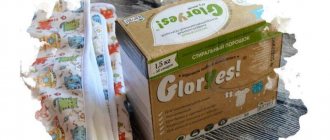The following incident prompted us to write this material: We purchased a camouflage suit “England” in the pattern “Jager/Moss moss”; the product was picked up by a relative of the buyer living in Moscow. Before use, the buyer decided to wash the suit... (The text of the correspondence and spelling are preserved in the original.)
Buyer:
Hello. I recently purchased an “England” suit from you and encountered a problem that during normal washing, whitish streaks and spots appear in the kinks. Wash on delicate wash at 40 degrees. Unfortunately, I couldn’t find any information on the Internet about how to properly wash such products, so I’m turning to you as the manufacturer. Tell me how to properly care for this suit and how to wash it. Thank you in advance!
ESR "Nine":
Greetings. A washing temperature of 30 or 40 degrees is normal for washing camouflage, the problem may arise due to insufficient rinsing of the remaining powder of the product after washing the military uniform, or you put more powder than necessary, or the machine does not pump in enough water to rinse the product. It is also possible that you put more things in the drum of the machine and there is simply not enough space for them so that the machine, when emptying them out, will turn them over and rinse them properly. It is possible that the powder does not dissolve completely and if after washing you wipe the drum inside, a whitish coating remains on it; this may depend on the powder itself and on the composition of the water, since the hardness of the water and the presence of impurities in it affect the solubility of the powders and precipitation in the form of a powdery substance is possible white. Try rinsing the suit by hand after washing the VKBO - the problem should disappear.
Buyer:
Hello. I wrote to you about a problem with my suit, about the appearance of whitish stripes. I tried rinsing it, but it got worse. If the paint is peeling off, then maybe you shouldn’t rub it at all, but just soak it? I’ll attach a photo for you: after washing, this is what it looked like after the first time I washed it. after rinsing is when I tried to remove the white streaks. Just tell me, can the paint peel off like that? I don't know the specifics of the fabric. I just don't want to ruin it completely.
(The photo clearly shows abrasions and quite strong lightening of the paint).
ESR "Nine":
If the paint is peeling off, then maybe you shouldn’t rub it at all, but just soak it? ——————The problem is not only in washing, in the photo where the bottom of the trousers is, it is clearly visible that the paint has been wiped off. The main problem with using suits in the field is that there is dust everywhere, when you move you sweat, the fabric absorbs moisture, dust sticks to it and rubs against all surrounding objects, and if the grass is also wet, then dust and water are more aggressive sandpaper, in all cases, there is mechanical wear of the fabric itself and the paint is wiped off accordingly (to put it roughly about printing a design on fabric, it is a kind of glue + water + dye that does not saturate the entire thickness of the fabric, as with “wet” monochromatic dyeing, that is, approximately like using a brush paper). The bottom of the trousers is more susceptible to mechanical wear. If the grass is tall and wet, then the trousers, when wet, form folds, and the top of this fold, experiencing the greatest load, is also wiped off. If you look closely at the wiped areas, the fabric on them is either more fleecy than on the non-wiped areas, or upon magnification, you can see that the fibers of the fabric are thinner than on the non-wiped areas. This is all a process of natural mechanical wear and tear. It is possible that the washing machine also adds something, since a crumpled suit also forms folds, and they rub against the drum. If you rub a soapy suit with a brush to wash it, then consider that you are rubbing the fabric with sandpaper. For fabric with a printed pattern, it is preferable to machine wash with powders without bleaches, and if we talk about thermal underwear or clothes made from membrane fabrics, only special liquid “conditioners.” More about thermal underwear: https://www.tactic-9.ru/index.php? module=page&slice=survival
Buyer:
Thanks for the answer. But you understand that I haven’t worn it anywhere yet. I just bought it, picked it up at the post office last Saturday. I decided to wash it before putting it on. After the first wash, the not yet worn suit began to show white stripes. I tried rinsing it in water, rubbing it a little, not too intensely, and it turned out like in the photo. It turns out that your paint quality is lousy? It would be okay if I went out somewhere in it at least once, but I only tried it on.
ESR "Nine":
If you have a “baby” type washing machine https://www.dombit.ru/index.php?categoryID=582 where a washer with blades rotates inside the tank, then the abrasions are definitely from the impact of these blades on the fabric, they are together with the dirt from the suit, spinning and stirring things up in the water kills paint faster than crawling through sand. I myself, in my youth, ruined more than one pair of jeans, and “wet” dyeing is by nature more durable than printing. If you are absolutely sure that the paint rubbing off was not due to the mechanical impact of anything on the suit (and it very much looks like it, especially the whitish stripes, as if the top of the fold was rubbing against something) then forward it. We will find where to do the examination, but if it is proven that the suit rubbed against something and the paint peeled off because of this, you, as not the right side, will have to pay for this examination. By the way, there is a proposal: we have scarves from the same batch of fabric dyeing, I propose: give 1 scarf to your mother for free so that she can wash it along with any other things, comparable in weight and volume to how they were washed you, if the effect is the same, we’ll deal with the rag; if the paint doesn’t sit, let your mother send the scarf to you (it’s cheaper than sending a suit) and you repeat her experience - let’s see what comes of it and then we’ll decide something.
Buyer:
The scarves washed fine. Tomorrow your mother will bring them to you. This means that the powder is still unsuitable. Then tell your clients not to wash their uniforms in baby powder, it’s called “Eared Nanny.” I hope the paint won't peel off like this in the future. If anything, I’ll come to you for a new suit))))))
ESR "Nine":
Greetings. Cold water, after being taken from the reservoir, is filtered, supplemented with disinfecting chemical additives, and served as “drinking water”. Hot water is purified runoff of cold water and water after rains from storm sewers (saving fresh natural water) or purified sea water, therefore it is absolutely not suitable for drinking and cooking, any chemicals may remain in it, and household washing machines They are connected mainly to cold water and heat it themselves. The presence of impurities in hot water depends on the efficiency of treatment facilities and the wear and tear of the entire supply system. The amount of added “disinfecting” impurities increases in the spring, when the snow melts, as well as during heavy rains, when all the dirt is washed away from the ground, the treatment plants cannot cope and more chemicals are added to the water. Try washing the scarf in the washing machine, adding some old things that you don’t mind for weight, and then using soap or powder by hand under warm water. I can give you another scarf for free so that you can wash one in the machine and the other by hand and compare.
Buyer:
My hot water is cold + heating tank. All the water here is spring water. I'll tell you a secret. Centralized hot water is supplied only in urban centers, and in Crimea, this did not exist at all. I'm making fun of one scarf. I just don’t understand why other things don’t deteriorate, this is the first time that something has faded. Maybe it really is the water... Well, never mind, I’ll describe everything to you, and I’ll definitely send you a photo, I’m interested in it myself. It’s raining today, I’ll put on a suit and walk around in the rain in it.
Buyer:
I would like to inform you that the reason for the paint wear on the suit has been found. Yesterday my wife decided to wipe a stain off her pink shorts. I soaped the pant leg with regular soap and rubbed it under running water, and I also got a white spot, as if the paint had been wiped off. Like this: Once your scarf arrives, we’ll try to torture it some more.
This is how, through experiments and doubts, the truth was achieved.
How to wash an army jacket?
For down jackets, a delicate machine wash cycle at a temperature of no more than 30 degrees is suitable. But jackets made of membrane fabric cannot be machine washed. They are only suitable for hand washing. It is advisable to use a special detergent so as not to damage the membrane jacket.
Interesting materials:
What to do to make a tree dry out? What to do to keep your home dust-free? What to do to prevent sneakers from turning yellow? What to do to keep terry towels soft? What to do to prevent metal from rusting? What to do to prevent wrinkles on your shoes? What to do to gain muscle mass? What should a woman do to gain weight? What to do to avoid diabetes? What to do to avoid ironing tulle?
Civil servant uniform
For office workers, clothing is not designed for field conditions, so it is made from more delicate fabrics. Unlike police and camouflage uniforms, it shrinks easily and shrinks in size, so it is important to control the heating temperature of the water. It is also necessary to take into account the following nuances:
- It is better to choose the “Delicate” program;
- water heating should be within 30-40 degrees;
- Chlorine-based bleaches are prohibited;
- turn on an additional rinse to completely clean the fibers from detergents;
- We reduce the spin to a minimum, since strong acceleration of the drum has a negative effect on the fabric.
The uniform of civil servants is made mainly from delicate fabrics - wool and astrakhan fur.
Automatic spinning is not suitable for delicate fabrics. It is safer to skip the spin cycle and carefully squeeze the mold by hand, not twisting it, but gently pressing it. Another option is to hang the “office” over the bathtub and use your palms to remove moisture from the material. Dry clothes only on a hanger and in a ventilated area.
Soaking clothes
Many questions about how to wash police or military uniforms are related to the fact that after washing the clothes shrink or fade. Therefore, it is very important to do proper soaking to fix the fabric and paint on it. This technique can be considered universal and can be used for all types of clothing.
- First you need to dilute the vinegar in water. Many manuals telling how to wash the Ministry of Emergency Situations uniform advise using a 1:1 ratio, but this should not be done. One glass of vinegar requires 10 liters of water.
- The liquid should be at room temperature. No heating.
- The clothes are placed in a container of water and soaked for 20 minutes. After which the colors on it should become brighter, more contrasting and obtain good fixation.
- Next, the items are washed with cold water and you can move on to the point that describes how to wash an office military uniform.
It is important to note that such soaking helps fix the dye, which was performed poorly in production. However, if the paint itself does not match the material used or there was a defect, then nothing can correct the situation.
Recommendations depending on fabric
A variety of fabrics and their combinations can be used for sewing. There are no differences in ironing classic male and female models.
But in women's models there are often additional decorative elements, the presence of which should also be taken into account during processing.
Wool
Ironing is carried out at “wool” or “silk” temperature with great care.
If handled inappropriately, the wool may stretch or, conversely, shrink. To prevent this from happening, the iron should not be moved over the fabric with force. It is best to carry out the treatment in small areas, applying and then removing the iron. In this case, the woolen fabric should be practically dry at the end of ironing.
Also, the treatment depends on the percentage of natural fibers in mixed fabrics: the more there are, the more careful the ironing should be.
Thick woolen fabrics may have lint on warm items. This circumstance must be taken into account when ironing, since the iron must move in the direction of the pile.
The plasticity and pliability of wool allows you to stretch the jacket a little at the ironing stage if it shrinks after washing.
Linen and cotton
Natural fabrics do not iron well when dry. In this regard, they should be smoothed out either not completely dried, or pre-moistened with a spray. Iron such a jacket from the inside out using steam.
Natural lightweight summer jackets made of cotton, linen or a mixture thereof may not have a lining. This option is often found in women's clothing. In this case, when ironing from the inside out, you do not need to use additional fabric.
Some types of linen fabrics are prohibited from ironing; this should be indicated on the label. A slight dent in such a thing will have its own special charm.
Synthetics
When ironing a product made of polyester or other synthetic fabric, you must turn off the steam function on the iron and set the minimum temperature setting.
Synthetics practically do not wrinkle, so proper storage allows you to always have a neat, even jacket without additional ironing.
Silk
Silk can be natural or artificial. Natural silk jackets cannot be ironed. Artificial - processed taking into account the recommendations on the tag on the inside of the product.
This is a very demanding material; it needs to be treated with care and delicately smoothed at a “silk” temperature.
When ironing silk, it is necessary not only to adhere to a temperature regime suitable for the fabric, but also not to hold the iron in one place for a long time.
Leather
A leather jacket is ironed only through additional fabric or craft paper, without holding the iron in one place for a long time.
The steam function cannot be used. The heating mode on the iron should be “silk”. You can give your jacket a steam bath or treat it with a steamer, avoiding excessive moisture.
If possible, it is better to simply leave a soft leather product hanging on a hanger for several days. It will straighten up under its own weight. You can learn about ways to iron leather products from this article.
Velveteen
You can iron a corduroy jacket only under the following conditions:
- from the wrong side;
- taking into account the direction of the pile;
- Do not process completely dry or completely wet fabric;
- do not press the iron with force;
- do not spray water on the front side of the jacket;
- use the steam function on the iron, or even better, use an uninterrupted steam supply.
You can iron such a jacket on a board only by placing a terry towel under the front side of the material. Otherwise, the pile may be damaged.
It is advisable to iron an item made of this material using a steamer, since using an iron can damage the texture of the material.
Washing police uniforms and casual clothing
For all types of clothes we will consider options using a washing machine. However, the process itself will have to be divided into two points, which is typical for such clothes. The fact is that the question of how to wash a police uniform in a machine should be considered only after proper soaking. The quality of the work performed will depend on this.
Machine washable
Before placing the product in the washing machine, you need to carefully study the washing instructions for individual workwear; it is possible that it only requires hand washing, or machine washing, but at low temperatures or without spinning.
If the manufacturer’s recommendations allow you to machine wash the product, then all conditions must be met; the process will follow the following algorithm:
It doesn’t really matter what kind of washing powder or liquid SMS you use to wash your workwear; a detergent that is used every day when washing other things is quite suitable; it’s better if it contains bioadditives.
Instead of powder, you can use gels intended for cleaning sportswear, since they often contain substances that help dissolve sweat, oils and salts, moreover, they are gentle on fabrics and are completely washed out of the fibers.
Advice: it is better not to use bleaching agents for items made of colored fabrics.
Important Rules
In order not to spoil the expensive uniform, we first carefully study the factory tag. On the label, the manufacturer lists the type of fabric and optimal conditions for cleaning it. It also doesn’t hurt to take into account several important general points.
- Water quality. In some cases, this becomes a big problem and greatly affects the final result. The fact is that the water supply contains a lot of chemicals, aluminum and chlorine, which, even with mild bleaches, discolor the fabric being washed. It is also bad with increased hardness, when the powder cannot dissolve, does not rinse out completely and settles on clothes as light spots and streaks. All this should be taken into account: organize a filtration system and rinse things repeatedly.
- Detergents. The selection of a suitable composition mainly depends on the type of fabric dyeing. Plain sets welcome any packaging marked “Color”, and multi-color camouflage is best washed with gentle gels. If the design was transferred to the form from paper, then we purchase a mixture that preserves the color of the material.
- Ironing. It is recommended to use a steamer instead of an iron.
- Spin. Automatic push-ups are undesirable; it is better to do them manually.
- Drying. Only naturally without batteries, hair dryers and dryers.
Military uniforms are dried in natural conditions - away from radiators and direct sunlight.
Membrane fabric requires special care. First of all, the heating temperature of the water is important, where the maximum is set at 30 degrees. Next, select delicate cleansing, turn off auto-spin and machine drying. We add a special gel to the tray and discard the rinse aid.
The dress uniform of police officers or emergency workers is cleaned differently. Here only the most gentle program and cold water are allowed - when heated above 40 degrees, the product will shrink at least one size. It is better not to take risks with home whitening and opt for dry cleaning.
Everyday military, police and office uniforms are quite durable, so they are easy to wash and practically do not deteriorate. The main thing is to read the label carefully and follow simple rules.
Interesting:
- What fabrics shrink when washed?
- What items should not be washed together in the washing machine?
- How to use Laska in the washing machine
- Washing a judo kimono in the washing machine
- How to wash a wired bra in the washing machine
- How to wash black clothes in a washing machine
Reader comments
- Share your opinion - leave a comment
What is a delicate wash cycle?
Delicate washing is not only the gentle washing of items made from thin fabrics, but also an individual approach to them (this is especially required for wool and silk). ... Delicate fabrics include wool and silk, nylon, polyester, lace, cambric, cashmere, knitwear, microfiber, lace.
Interesting materials:
Where can you find tin? Where can I find answers to the exam? Where can I exchange coins? Where can I register an inheritance? Where can I get a certificate of no criminal record? Where can I publish my prose? Where can you relax on the lake in Yekaterinburg? Where can you relax in the fall of 2022? Where can you relax in 2022? Where can I send a registered letter?
Selecting detergents
To maximize the removal of contaminants, it is necessary to choose the right product for home washing of dirty workwear.
The modern chemical industry is ready to present many different products that allow you to remove any stains.
The most gentle way is to soak and wash clothes using ordinary laundry soap, possibly with the addition of soda.
To remove more stubborn stains, you can use active alkalis, such as sodium, but you need to use it very carefully and in small concentrations, otherwise you can damage the fabric structure.
Sodium hydroxide can be used when boiling work clothes, if the care instructions allow it, you need to stir the clothes periodically during the boiling process, otherwise they may not clean evenly or stick to the bottom of the pan.
To get rid of oily, greasy or petroleum stains, you need to use special products developed on the basis of petroleum products; dishwashing detergents can also help.
Note: high-quality workwear should be able to withstand up to 20 washes painlessly.
Gabardine trousers: care features
Gabardine is a fabric whose threads are woven at an angle. Thanks to this material:
It has a fairly high density, but is also very light. Gabardine trousers are comfortable to wear even in the hottest weather. Moreover, its composition can be absolutely anything - natural and artificial threads, as well as their combinations, are used to create different types of fabric.
Gabardine should only be ironed from the inside out, when slightly damp. To maintain the matte texture of the material, use a thin cotton cloth, several layers of gauze or a special textile cover. The iron should be warm, but not hot; You need to iron until the fabric is completely dry.
Some nuances
Before you wash your camouflage uniform, you need to look at the label. It will indicate the type of fabric and optimal washing conditions.
In order not to spoil your uniform, you need to consider some points:
If you follow all the rules and recommendations, cleaning your military uniform will not be difficult. The main thing is that she doesn’t sit down. The ceremonial uniform of the police or the Ministry of Emergency Situations deserves special attention. It is washed using the most gentle cycle. Hot water will cause the fabric to shrink at least two sizes. Therefore, it is better not to experiment, but to immediately take the item to the dry cleaner. The everyday uniform is more durable and wear-resistant, so it is not so difficult to care for. When ironing, it is convenient to use a steamer instead of a regular iron. That's all the wisdom. By following simple tips, you can easily keep the shape clean without compromising the color.
Caring for your camouflage uniform
Military uniforms get dirty faster and more seriously. As a rule, you have to deal with persistent “field” pollution: grass, blood, oil and soil . You can deal with such stains only by pre-soaking. To fully clean the camouflage, we proceed as follows.
If the camouflage has stains from grass, blood or oil, then pre-soaking and washing is necessary.
After double soaking, the camouflage will be brighter, will get rid of the unpleasant odor, and the fabric itself will become softer. Air conditioning wouldn't hurt either, although it's better for military personnel to use neutral scents so as not to stand out. As for setting up the machine, everything is according to the standard: the water temperature is about 40 degrees, and the spin speed is 800-1000 revolutions.
Rules for organizing washing and dry cleaning of workwear at enterprises
Care of workwear at an enterprise can be carried out by involved organizations that provide relevant services. However, many, especially large enterprises with a fairly large workforce, prefer to organize their own laundries.
GOST R 56247-2014 regulates the organization and operation of industrial laundries, which wash textiles for hotels, catering establishments, transport and passenger companies, medical organizations, sports and recreation centers, organizations of the Ministry of Emergency Situations and the police, construction, trading and other companies.
Everything is standardized: from the room in which a laundry can be located, to the sorting of laundry and environmental friendliness of work. Of course, everything depends on the volume of workwear, the number of personnel, and the specifics of the enterprise’s activities.
The main thing that employees and employers should know is that an employee has the right to demand that workwear be washed or repaired, but he must notify the employer about this in advance.
How to restore color to black clothes at home
To restore the rich shade of black products without much money or time, you can use simple folk recipes. There are several proven methods that will quickly put a dark thing in order. In the process, available ingredients will be used.
Tobacco
Dry tobacco mixture is used not only for smoking, but also for restoring color to faded dark things. Surprisingly, ordinary cigarette tobacco gives black products a new life. The prepared solution is suitable for any material, even wool, velvet, and knitwear. The main condition is correct processing depending on the size of the product.
Recipe one:
- Take a liter of water and pour it into a metal container.
- Boil water, add 15 grams of tobacco.
- Leave the mixture in a water bath for 30 minutes.
- Cool the solution, strain, let the item sit for half an hour, rinse and dry.
You should end up with slightly brownish water. The method is perfect for T-shirts, scarves, socks and other cotton items. If the product is large in size, then it is treated point by point with a solution already prepared according to the instructions above.
Method:
- Prepare the same brown water;
- We take a clean, dry product and lay it out on the table;
- Then moisten the desired areas with a sponge and wait until dry.
This method will help if your black jeans, dress, coat, or robe have faded. It is worth remembering that not everyone likes the smell of tobacco, so after processing the large product is dried in the open air, and the small product is washed with powder for dark material.
Coffee to the rescue
Coffee is ideal for returning the rich color to faded items. It flavors the product; after treatment, your favorite trousers or dress will emit a subtle, pleasant coffee aroma. So, how to return the black color to faded things using coffee:
- Take a liter of hot water.
- Add 50 grams of instant coffee.
- Mix everything and let the drink cool.
- Next, process the product and dry it.
To achieve the desired effect, clothes are pre-washed and allowed to dry. The item can be soaked in the resulting solution for half an hour, then dried in the fresh air. Coffee is also often replaced with black tea. The cooking recipe is the same.
Vinegar
The vinegar solution retains the shade and gives the product its original rich black color. To prepare it, take a spoonful of vinegar and a liter of water. Then leave the item for half an hour, rinse, and dry in the fresh air.
It is important not to overexpose the fabric for more than 30 minutes, otherwise the item of clothing will settle. The rule applies not only to vinegar soaking, but also to other methods
Soda and salt
Two ingredients, using filtered water, adds blackness and shine to faded or faded items. To prepare, take a pinch of salt and a tablespoon of soda, add water, and soak the item for half an hour. Next, it is rinsed and dried. You can pour a little washing gel into the solution. Before soaking, clothes are washed and dried. The mixture is also boiled over low heat (30 minutes).
Other home methods
If your black jeans have faded and you don't know how to get the color back, try re-washing them with old dark clothes. Place the products for 15 minutes in warm water without powder, then wash in a machine. To improve the result, the wash is stopped in the middle of the cycle so that the items are properly colored. It is better to use old wool sweaters that fade after numerous washes. The clothes are then removed and rinsed in a vinegar solution that sets the dye.
You can also rinse or wash your wardrobe item in water with black mascara added. Some laundry detergents labeled “for black” do a good job of restoring color. Add more product than usual. In severe cases, repeated washings in this manner will be necessary. Ammonia has proven itself well. The solution consists of a liter of water and 20 ml of medicine, in which the laundry is soaked for 15 minutes.
How to wash an office uniform
Unlike field clothing, the fabric of such products cannot boast of high strength and practicality. It shrinks when washed and may even shrink in some places. Therefore, it is very important to decide at what temperature to wash your military uniform.
On modern washing machines there are many different modes that can be used for such laundry. The main thing is that the water temperature does not exceed 40 degrees.
Also answering the question of how to wash uniforms, many experts recommend almost completely avoiding spinning. It is better to do it by hand, and when drying the product, place a container under it to drain the liquid.
Workwear washing schedule
The regulations state that an employee may require his workwear to be washed.
Of course, in an emergency situation this is applicable, but it is more convenient when all actions take place as planned. This makes it convenient to distribute the load on the laundry and maintain order in the company. Typically, workwear is washed according to a washing schedule. There are no special requirements for the design of the washing schedule; it is important that it contains the following columns:
- Name of the unit, department, team, warehouse, etc. A small company may maintain a schedule indicating the names of employees.
- Responsible person (chief, department head).
- Wash time (days of the week or month are marked).
- Completion mark.
(there should be a picture here - a screenshot of the schedule)
In some organizations, the schedule and laundry log are combined into one document.
Inside the department, to make it convenient, each set is signed so that the employee can receive his own clothes, and not someone else’s clothes of the same size. If washing is carried out on weekdays, then each employee must have a full set of spare work clothes for their shift.
schedule for washing workwear (here make a file in Excel)











